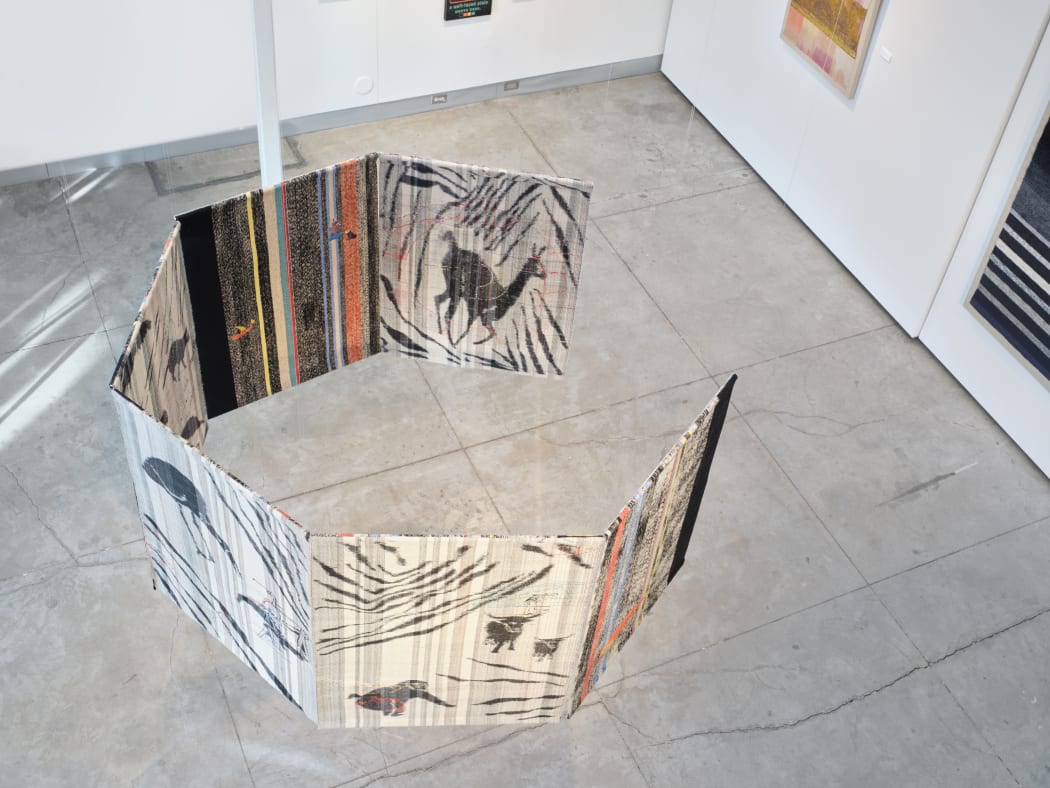
Curatorial Statement
“Weaving is always slow compared to most methods of making,” Bhakti Ziek recently wrote to me. For example, when she hand-weaves a brocade structure, Ziek can complete about one quarter-inch passage per hour at most. Look around this retrospective, representing over 50 years of Ziek’s fiber practice, and consider the patient math of her monumental endeavor. A Tenuous Thread captures the dynamic between Ziek’s voracious artistic intellect and humanity’s most intricate and painstaking sculptural discipline. The exhibition also charts the technological leaps that brought Ziek into prolific harmony with her practice.
Now a septuagenarian living in Santa Fe, Ziek has traveled the world seeking craft knowledge and artistic inspiration. Her path begins in New York City, where she was born in 1946 and first studied weaving at the Craft Students League. It winds through Mexico, Guatemala, Kansas, Michigan’s Cranbrook Academy of Art, the Philadelphia College of Textiles & Science (PCT&S), Chicago, Arizona, India, Italy, Vermont, and beyond.
The foundation of Ziek’s weaving practice is analog; early in her career, she mastered myriad weave structures by hand on the floor loom, backstrap loom and tapestry loom. She first encountered a jacquard loom, which automates elements of the weaving process, in 1986 during her studies in Manhattan. In 1991, she was teaching at PCT&S when the institution swapped its 19th-century jacquard looms for fully electronic jacquards that could be digitally programmed.
Ziek has since established herself as a preeminent scholarly authority on the artistic use of the computerized jacquard loom—and has used the technology to supercharge her own practice. A Tenuous Thread features artworks from every phase of Ziek’s creative evolution, from her formative studies of techniques and aesthetics across the world, to her career-spanning efforts to textually surface the knowledge that is encoded in her textiles.
One entry point to this exhibition is Wheel of Life, Ziek’s early-career magnum opus that wrestles with legacies of the theft and dissemination of knowledge in craft community. There are two churning endpoints: Ziek’s floor loom, which she will activate throughout the show, and a display of her former students on our second-floor catwalk.
-Jordan Eddy, Director

artist STATEMENT
I’ve tried to live a holistic life, honoring my general curiosity, acknowledging the wonderful diversity of human societies while noting the similarities of our species. I didn’t intend to be a weaver; it began as a tenuous thread, but it became my lifeline. It didn’t lead to a concise understanding of the world or even of the nature of weaving itself, but unfolded into ever-evolving questions about the mechanism of the process, what it has been, can be, and what could I make of it.
References to weaving abound in literature throughout human history. The process of weaving takes hundreds of individual threads, and combines them into a cohesive plane. It is the perfect metaphor for how we build our lives from multiple identities and interests into a singular personality. It is also a good metaphor for interconnectedness of any sort—family, community, governance. Weaving doesn’t always yield narratives, but in my work, the resulting combination of images and words reveal a propensity towards storytelling. Rooted in the physical making of the work, I honor the skill that has developed in my hands from years of weaving; and I listen for the insights that arise from my hands to my head, and vice versa.
Almost from the start, I tried to map my mental activities in a series of woven collages. Just as thoughts loop, certain imagery is found again and again—my handwritten calculations for converting images into physical threads, repetitive counting, diagrams, and glimpses of nature are some of the phenomena that fill my head and these canvases. Over the years my work has seesawed between identifiable narratives and abstract imagery; my quest to understand spiritual systems has entered the weavings in recognized and abstract symbols; and I never shied away from beauty.
I consider all work as studies, just one step on the path from here to there—and who knows where there is going to end up being. However, with time, the nature of weaving itself became more prominent in my work. So you find notations about how they are made, diagrams of weave drafts, and recordings of their materials. This also became helpful in my teaching. Instead of looking for written notes on the work, I could just refer to the work itself.
Weaving has been the thread that has held my life together for more than fifty years. One has to fill the minutes, hours, days and years that are given to you with something, and it seems that weaving chose me. In essence, I see my life as the latest iteration in the long line of weavers that stretch back beyond recorded history. I feel blessed to be in this lineage.
-Bhakti Ziek